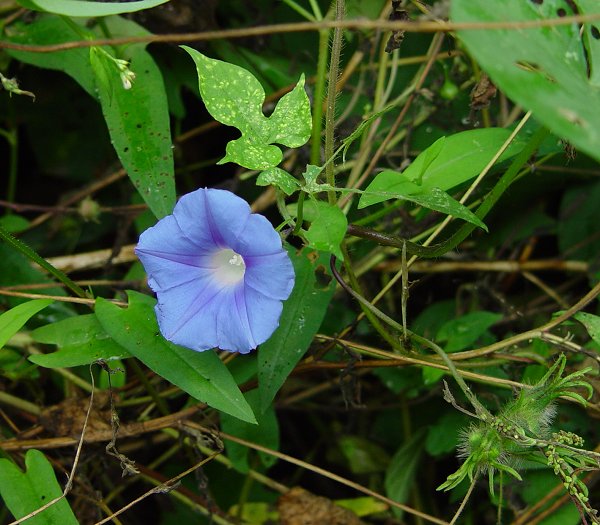Ipomoea hederacea Jacq.
Blue Morning Glory

Introduced
CC = *
CW = 3
MOC = 68
© DETenaglia
Ipomoea hederacea Jacq.Blue Morning Glory | |
 |
Introduced CC = * CW = 3 MOC = 68 |
© DETenaglia |
|
Family - Convolvulaceae Habit - Annual forb. Stems - Vining, twining, sprawling or climbing, to 2.5 m, moderately to densely pubescent with relatively long, spreading to downward-angled hairs or with a combination of long and short pubescence.
Leaves - Alternate, usually lobed, long-petiolate. Petioles to 12 cm, pubescent, with a shallow adaxial groove. Blades 2-12 cm long, unlobed or more commonly deeply 3-lobed, the lobes triangular, broadly ovate to ovate-triangular in overall outline, tapered to a sharply pointed tip, shallowly to more commonly deeply cordate at the base, both surfaces moderately pubescent with straight, appressed to spreading hairs, the margins otherwise entire.
Inflorescences - Flowers axillary, solitary or more commonly in loose clusters of 2 or 3, the stalks moderately to densely pubescent with relatively long, spreading to downward-angled hairs. Peduncles to 6 cm long, pubescent, often purple at the base. Pedicels short, 3-5 mm long, retrorse-pubescent. Inflorescence divisions subtended by opposite linear-attenuate bracts, these to 3 cm long, 2-3 mm broad, pubescent, reduced upwards.
Flowers - Sepals similar in size and shape, 12-25 mm long, with a short, ovate basal portion and an outward-curled, long-tapered, sharply pointed, linear tip, the surface and margins moderately to densely pubescent with relatively long, spreading to downward-angled hairs. Corollas 2.5-5.0 cm long, funnelform to slightly bell-shaped, the tube widened gradually toward the tip, purple or sky blue with a white or yellowish white center. Stamens 5, not exserted, adnate near the base of the corolla tube. Filaments white, to 1.5 cm long, mostly glabrous but with distinct thickened hairs at the base. Anthers white, 2 mm long, 1.5 mm broad. Ovary superior, white, glabrous, subtended by white nectariferous ring, 3-locular, the stigma 3-lobed. Placentation axile.
Fruits - Globose or depressed-globose capsules, the main body 8-12 mm long, the persistent style 4-15 mm long, glabrous. Seeds 4-5 mm long, the surface moderately to densely minutely hairy.
Flowering - June - October. Habitat - Streambanks, fields, fields, gardens, pastures, fencerows, ditches, railroads, roadsides, open disturbed areas. Origin - Native to Central and South America. Lookalikes - I. purpurea. Other info. - This attractive vine is closely related to the commonly cultivated morning glory. It is found throughout Missouri, most of the eastern U.S., and parts of the southwestern U.S. It is easily recognized by its vining habit and distinctive flowers. The leaves are usually lobed, as shown above, but in some cases can be unlobed. The flowers are normally blue but can also be purple. This species is distinguished from the closely related lookalike I. purpurea (which is the commonly cultivated morning glory) by its long, slender calyx lobes. Those of I. purpurea are triangular instead. This species frequently occurs in flower beds and cultivated areas. The flowers only last one day before wilting. Because this species is found throughout the world there is some confusion about its origin. Most tend to agree the plant is from the American tropics. Photographs taken in Brown Summit, NC., 9-8-02 (DETenaglia); also along the Katy Trail near Marthasville, Warren County, MO, 7-15-2007, and along the Katy Trail near Dutzow, Warren County, MO, 8-13-2014 and 8-20-2021 (SRTurner). |